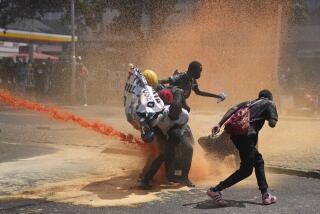Doctors Restore Kenyans’ Dignity
- Share via
NAIROBI, Kenya — Despite the more than 100 stitches holding his jaw in place and another 100 patching up a skin graft, 13-year-old David Maina just learned how to smile again.
David was sitting on a school bus Aug. 7 when a piece of debris came flying through the window and blew away his lower jaw. Several of his teeth were shattered or became part of the mountains of rubble that remained after the bombing of the U.S. Embassy in Nairobi, Kenya’s capital.
Last week, Maina got his jaw back.
He was one of 350 Kenyans injured in the blast who were selected to receive free plastic and reconstructive surgery from American, Spanish and Kenyan specialists.
The explosion killed 213 people and injured more than 5,000. A near-simultaneous explosion at the U.S. Embassy in neighboring Tanzania killed 11.
Volunteer doctors, among them several Californians, said they wanted to restore hope and confidence in victims.
“It was frustrating to just sit and watch it on TV,” said David Furnas, a clinical professor and chief of plastic surgery at UC Irvine, who coordinated a team of four U.S. surgeons. “This is a way to play a role. It is important for us to do the best we can to make our contribution.”
The program, which cost at least $500,000, is being funded by the U.S. Agency for International Development and the Nairobi-based African Medical and Research Foundation, or AMREF. Several foreign and local organizations donated equipment, facilities, transportation and expertise.
“It’s not that the Kenyan surgeons are not capable,” said Marlene Long, a native of San Diego who is AMREF’s resident reconstructive surgeon for East Africa. “It’s the volume . . . of people who have been affected by [the bombing] and are anxious to have their surgery.”
Working with the surgeons at Nairobi’s Kenyatta National Hospital are anesthesiologists, certified nurse technicians and staff nurses.
“It’s a very small way Americans can say we care about the Kenyan people,” said Furnas’ wife, Mary Lou, who is a certified surgical technician.
Long said that on the basis of a screening last year, AMREF judged 750 patients to be candidates for treatment by the visiting surgeons. By the end of their two-week stay today, the specialists planned to see 350 of them.
Wounds have ranged from lacerations and torn tendons to drooping eyelids and horrific disfigurements caused by improper healing. Chunks of glass and debris have been removed from mangled faces, necks and limbs.
“The most common problem is scarring,” said Furnas, 67, who briefly worked in Kenya in the early 1970s. “We remove them [scars] meticulously. We give nature the best chance of creating a more inconspicuous scar. For each patient, these scars are important. They are a reminder of a great tragedy.”
However, the doctors emphasized that they do not want to give false hope because the location and character of a scar determine whether or not it can actually be repaired.
“We’re not getting rid of stuff; what we’re doing is diminishing,” said Hale Tolleth, 68, a reconstructive surgeon from Concord, Calif. “We repair and make whole.”
Kenyan doctors earlier had grafted bone from Maina’s hip to replace some of his lost jaw. The plastic surgeons used a skin graft from his groin to elevate what remained of the inside of the teenager’s mouth and build up the lining there. Then came the challenge of piecing together, remolding and sculpting David’s new jaw.
The teenager’s operation, which took five hours, was one of the toughest, Furnas said.
Other surgical procedures to reduce scarring have taken as little as an hour.
Caroline Wangalwa hoped her surgery Monday to repair gashes in her forehead and the right side of her face would help her win back the affection of her children.
“My face was spoiled,” said Wangalwa, 37. She is the mother of three children. She was pregnant with the youngest, her 4-month-old, when she was injured by the bombing.
“My kids, they feared me so much,” she said. “They were asking, ‘Mum where did you get that scar?’ They were even afraid to come near me.”
She was less than confident that she would get the kind of postoperative care she needed to fully recover from the blast, which also left her with constant headaches and watering eyes. She said she could not afford to pay for it on her salary as a government accountant.
Long said her organization would try to ensure a degree of postoperative care but that many people probably would not be able to get any.
Many Kenyans, however, expressed gratitude that people cared enough to travel so far to lend a helping hand.
“It shows the true way of doing charity,” said Meshach Onguti, Kenyatta National Hospital’s chief plastic and reconstructive surgeon. “I don’t think people remember the money that has been donated. If you do a service for someone, that is what has a lasting effect.”
More to Read
Sign up for Essential California
The most important California stories and recommendations in your inbox every morning.
You may occasionally receive promotional content from the Los Angeles Times.














